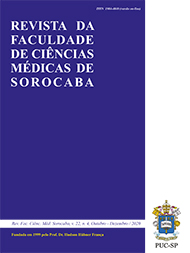Cirurgia com neurofisiologia intraoperatória para ressecção microcirúrgica dos gliomas de alto grau de área motora em pacientes desacordados com anestesia geral (asleep)
Melhor resultado que em pacientes acordados com testes funcionais?
DOI:
https://doi.org/10.23925/1984-4840.2020v22i4a6Palavras-chave:
Craniotomia, Gliomas, Neurocirurgia, NeurofisiologiaResumo
Introdução: Os gliomas difusos são tumores primários do sistema nervoso central, que, apesar da melhoria das técnicas para os tratamentos, continuam como desafios para a medicina dados os seus padrões dinâmicos de crescimento e comportamento. Atualmente, uma das alternativas de tratamento estudadas pauta-se na porcentagem da ressecção e na área eloquente envolvida. A porcentagem de ressecção é um importante fator prognóstico independente que define a sobrevida nos pacientes. Objetivo: Mostrar a casuística da abordagem cirúrgica asleep de tumores em área motora. Método: Estudo retrospectivo em pacientes submetidos a ressecção cirúrgica asleep de gliomas de alto grau, com monitoração eletrofisiológica intraoperatória somatossensitivo motora, com ressecção dos tipos parcial, subtotal e total, por meio de craniotomia e microcirurgia. A análise dos resultados baseou-se na avaliação da evolução pós-operatória pela Escala de Karnofsky. Resultados: Na amostra verificada, pode-se aventar que a técnica operatória asleep é segura na abordagem nas áreas motoras. Todos os pacientes que apresentaram déficits evoluíram para óbito em razão do caráter agressivo da doença. Conclusão: Pode-se concluir que a técnica operatória asleep é segura quanto à abordagem nas áreas motoras, com complicação intraoperatória extremamente baixa e evolução prognóstica a depender da agressividade inicial do tumor.
Referências
Mendes GA, Ongaratti BR, Semmelmann Pereira-Lima JF. Epidemiologia de uma série de tumores primários do sistema nervoso central. Arq Bras Neurocir Braz Neurosurg. 2014;33(04):279-83. https://doi.org/10.1055/s-0038-1626227
Barbosa ARSO. Craniotomia para resseção de astrocitoma em área funcional com doente acordado [dissertação]. Porto: Instituto de Ciências Biomédicas Abel Salazar. Universidade do Porto; 2012.
Henrique M, Faria G, Maria R, Helena S, Rabenhorst B. Estratégias auxiliares para graduação dos tumores astrocíticos segundo os critérios histopatológicos estabelecidos pela OMS. J Bras Patol Med Lab. 2006;2(5):401-10. https://doi.org/10.1590/S1676-24442006000500012
Kleihues P, Louis DN, Scheithauer BW, Rorke LB, Reifenberger G, Burger PC, Cavenee WK. The WHO classification of tumors of the nervous system. J Neuropathol Exp Neurol. 2002;61(3):215-25; discussion 226-9. https://doi.org/10.1093/jnen/61.3.215
Viterbo MB. Astrocitomas do sistema nervoso central: correlação do grau de ressecação tumoral e prognóstico [dissertação]. São Paulo: Hospital Heliópolis; 2008.
Bogosavljevic V, Tasic G, Nestorovic B, Jovanovic V, Rakic M, Samardzic M. Surgical treatment of glioblastoma multiforme localized in the motor area of the brain using the technique of cortical electrostimulation. Turk Neurosurg. 2012;22(2):135-40. https://doi.org/10.5137/1019-5149.JTN.3980-10.2
Lopes TG, Castilho-Fernandes A, Tedesco AC. Ampla caracterização do glioblastoma e abordagens terapêuticas. Rev Univ Vale Rio Verde. 2012;10(2):12-25. https://doi.org/10.5892/ruvrv.2012.102.1225
Lucena RDCG, Mello RJV, Lessa JR, Cavalcante GM, Ribeiro M. Correlação clínico-topográfica em glioblastomas multiformes nas síndromes motoras: significados fisiopatológicos. Arq Neuro-Psiquiatr. 2006;64(2 B):441-5. https://doi.org/10.1590/S0004-282X2006000300017
Viegas SFJ. Tumor cerebral incidência, diagnóstico e tratamento [Internet]. Faro: Universidade do Algarve; 2010. 35 [acessado em 25 maio 2018]. Disponível em:
https://sapientia.ualg.pt/bitstream/10400.1/4913/1/PROJECTO_SusanaViegas_2010.pdf
Shah KB, Hayman LA, Chavali LS, Hamilton JD, Prabhu SS, Wangaryattawanich P, et al. Glial tumors in brodmann area 6: Spread pattern and relationships to motor areas. Radiographics. 2015;35(3):793-803. https://doi.org/10.1148/rg.2015140207
Badke GL, Panagopoulos AT, Aguiar GB, Veiga JCE. Glioblastoma multiforme em idosos: uma revisão sobre seu tratamento com ênfase na abordagem cirúrgica. Arq Bras Neurocir. 2014;33(1):45-51. https://doi.org/10.1055/s-0038-1626199
Fonseca CO, Fischer JSG, Masini M, Futuro D, Caetano R, Gattass CR, Santos TQ. Oligodendrogliomas: a genética molecular e o desenvolvimento de estratégia terapêutica adjuvante. Arq Bras Neurocir: Braz Neurosurg. 2007;26(1):08-15.
Ojemann G. Cognitive mapping through electrophysiology. Epilepsia. 2010;51(Suppl. 1):72-5. https://doi.org/10.1111/j.1528-1167.2009.02453.x
Alves P. Abordagem terapêutica de gliomas cerebrais de alto grau [dissertação]. Covilhã: Universidade da Beira Interior; 2014.
Hathout L, Ellingson B, Pope W. Modeling the efficacy of the extent of surgical resection in the setting of radiation therapy for glioblastoma. Cancer Sci. 2016;107(8):1110-6. https://doi.org/10.1111/cas.12979
Downloads
Publicado
Como Citar
Licença
Copyright (c) 2022 Revista da Faculdade de Ciências Médicas de Sorocaba

Este trabalho está licenciado sob uma licença Creative Commons Attribution-NonCommercial 4.0 International License.
Os autores no momento da submissão transferem os direitos autorais, assim, os manuscritos publicados passam a ser propriedade da revista.
O conteúdo do periódico está licenciado sob uma Licença Creative Commons 4.0, esta licença permite o livre acesso imediato ao trabalho e que qualquer usuário leia, baixe, copie, distribua, imprima, pesquise ou vincule aos textos completos dos artigos, rastreando-os para indexação, passá-los como dados para o software, ou usá-los para qualquer outra finalidade legal.

 Este obra está licenciada com uma Licença
Este obra está licenciada com uma Licença 